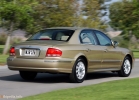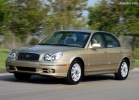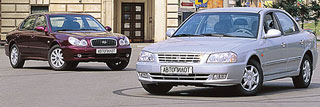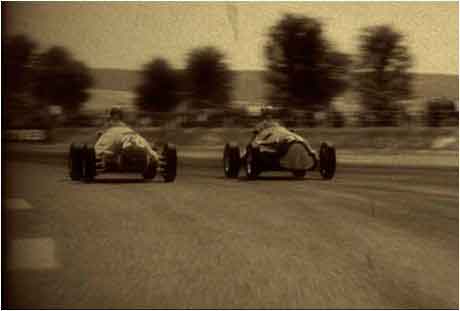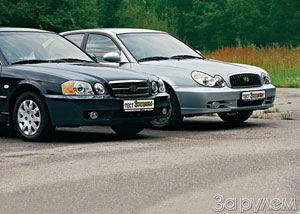Hyundai Sonata 2001 test drive - 2004 sedan
Music is a kind
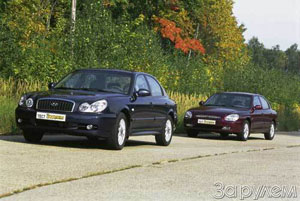 The first Hyunde Sonata saw the light in 1988. A year later, a V-shaped three-liter six appeared under her hood. The second generation of sonata was represented by the public in 1993. The next deep modernization of the machine occurred in 1996 (Sonata-III), and a completely new fourth-generation car went into production in 1998. Then a new six of 2.5 liters appeared. 2001 - the time of birth of the fifth sonata, representing a serious restyling of the fourth -generation model with a new 2.7 liter engine and a modernized 4 -cylinder 2.0 liters.
The first Hyunde Sonata saw the light in 1988. A year later, a V-shaped three-liter six appeared under her hood. The second generation of sonata was represented by the public in 1993. The next deep modernization of the machine occurred in 1996 (Sonata-III), and a completely new fourth-generation car went into production in 1998. Then a new six of 2.5 liters appeared. 2001 - the time of birth of the fifth sonata, representing a serious restyling of the fourth -generation model with a new 2.7 liter engine and a modernized 4 -cylinder 2.0 liters. Sonata is a musical, piano composition of a kind. V. Dal
As you know, in music it is very important not to go astray. Therefore, in order not to get confused in Hyunde's piano works, we decided to take two cars for the test: the latest sonata-V and its predecessor version IV. In addition to a very expressive appearance in the asset of the novelty, the V -shaped six with a volume of 2.7 liters and a capacity of 127 kW paired with a four -speed sequential automatic transmission - the development of the Namyang research center. The old woman with the IV index looks simpler, and it is not loaded so solid: a two -liter four with a capacity of 96 kW and a traditional five -speed mechanics. However, the purpose of acquaintance is not so much in contrasting dynamic qualities, but in the search for changes that distinguish a new version of the machine from the old.
Muse of our time
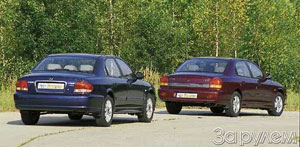 If you think about it, the idea of \u200b\u200ban almost annual renewal of the car is not so bad. At least, looking at our wards, you feel very sharply that the previous, fourth, is already outdated. The fifth has changed underlot for the body, bumpers, a false radiator grille, became more expressive than the headlights and rear lights, chromium was noticeably increased. The new car, like a sponge, absorbed all the innovations and finds of modern design, becoming more expressive and somehow wider. Perhaps even respectable. The car not only increased in size - it seemed to have matured for these few years. Let us pay tribute - the stylists managed to maintain the features of traditional Hyundy appearance, and the car remained recognizable.
If you think about it, the idea of \u200b\u200ban almost annual renewal of the car is not so bad. At least, looking at our wards, you feel very sharply that the previous, fourth, is already outdated. The fifth has changed underlot for the body, bumpers, a false radiator grille, became more expressive than the headlights and rear lights, chromium was noticeably increased. The new car, like a sponge, absorbed all the innovations and finds of modern design, becoming more expressive and somehow wider. Perhaps even respectable. The car not only increased in size - it seemed to have matured for these few years. Let us pay tribute - the stylists managed to maintain the features of traditional Hyundy appearance, and the car remained recognizable. Changes in the interior are much less revolutionary. The same dimensions of the door openings, the same skin in the GLS version, prevailing in upholstery, similar inserts under a tree on the central console. And yet in the new sonata it is more convenient and comfortable. Why? Of course, other combinations of devices and the central console cause a feeling of novelty. Old devices, as it seems now, look cheap - small digitization of scales, an inconspicuous window of the climate installation display. On the fifth, all this is much more expressive and, again, in the spirit of time. And yet the matter is not only in the instruments. The feeling of comfort is created by those several millimeters that the size of the cabin added. It seems to be the same seats, the same set of mechanical adjustments, but you sit in a new machine in a different way - first of all, more spacious. Nevertheless, Sonata-V is also not perfect. The roof hangs over the head, both in front and behind. It also became a little more spacious, even a headrest appeared for the third passenger. However, he looks like an advance, the promise of the future sonata-VI-after all, only two in the back seat is really comfortable.
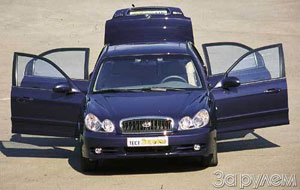 Movement energy
Movement energy Before hanging measuring equipment, let's look at cars. If you discard some layout differences, the use of different engines and gearboxes, everything else in sonatas is the same - at least during a superficial examination. The design of the chassis has not changed.
But the new engine deserves praise. Its capabilities in tandem with the most important automaton were unexpected. Powerful, assertive acceleration, not at all automatic sensitivity of the car to the accelerator pedal - and at the same time amazing soft switching. As if a powerful rubber tourniquet carries the sonata forward, it is worthwhile to click on the accelerator. But the car is especially convenient with smooth movement: a powerful engine allows the box to choose and hold the desired gear in a timely and timely, without tiring passengers with frequent (and often unnecessary) switching. Well, for choleraiks or, conversely, phlegmatics there is a sectral (that is, manual) control mode. So with a quick ride, easily besieged the car before turning, using low transmissions, or, conversely, leisurely accelerated to 70-80 km/h, forced to turn on the fourth and roll, using only an accelerator. Fortunately, in the latter case, the brains of the box almost do not affect the process of movement.
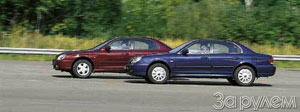 The next thing you will involuntarily pay attention to is excellent acoustic comfort. No unpleasant noise or vibrations. Somewhere there, far under the hood, the engine rumbles, the tires rustling, the dissected air whistles slightly. However, no extra sounds that interfere with the conversation passes into the salon.
The next thing you will involuntarily pay attention to is excellent acoustic comfort. No unpleasant noise or vibrations. Somewhere there, far under the hood, the engine rumbles, the tires rustling, the dissected air whistles slightly. However, no extra sounds that interfere with the conversation passes into the salon. The work of the brake system is already expectedly reliable. A clear pedal with good feedback, unobtrusive ABS help without problems stopping a one and a half -ton car. The only thing she behaves a little nervous is braking from speeds close to maximum. Here, sonata sometimes shows not the best character traits, striving to roar to the side.
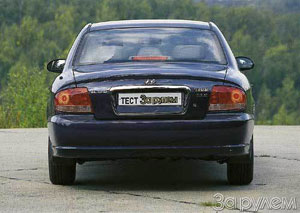 The pendants and everything connected with them left a dual sensation. Sonata is clearly configured to move on smooth roads of the European level. In such conditions, the car is quite comfortable and very reliably monitors all the driver’s teams. Only too light and uninformative in turning the steering wheel does not allow to control the behavior of the machine to the subtleties. However, it is worth an almost perfect coating to be replaced by rough and wavy asphalt - small irregularities immediately climb onto the steering wheel, making themselves felt and passengers. You will not dismiss from unpleasant vertical swing on gentle waves. At high speeds, these endless take-offs and falls are so tiring that I want to ask for mercy. But this is still half a worm. When it gets in a quick turn on irregularities, the arising body build -up also straightens the given trajectory of movement, forcing the driver to work hard. But it is worth getting to the flat section of the road, as the sonata again becomes obedient and flexible.
The pendants and everything connected with them left a dual sensation. Sonata is clearly configured to move on smooth roads of the European level. In such conditions, the car is quite comfortable and very reliably monitors all the driver’s teams. Only too light and uninformative in turning the steering wheel does not allow to control the behavior of the machine to the subtleties. However, it is worth an almost perfect coating to be replaced by rough and wavy asphalt - small irregularities immediately climb onto the steering wheel, making themselves felt and passengers. You will not dismiss from unpleasant vertical swing on gentle waves. At high speeds, these endless take-offs and falls are so tiring that I want to ask for mercy. But this is still half a worm. When it gets in a quick turn on irregularities, the arising body build -up also straightens the given trajectory of movement, forcing the driver to work hard. But it is worth getting to the flat section of the road, as the sonata again becomes obedient and flexible. Well, what about the old woman? In it, alas, there is no such delightful dynamics, and the transfers of the mechanics are clearly stretched. But even this car is convenient and kind in its responses to the driver’s actions. It is, of course, noisier - mainly because of the shrill engine. But it allows the driver to feel more confident in the coating of unimportant quality. And the management is not so norovist. Apparently, the 100-kilogram difference in the weight of the machines affects, due to which light sonata-IV suspensions work in more favorable conditions. Although, in general, the fourth is inherent in the same disadvantages, only manifested at more speedy speeds and accelerations.
 Will they love them here?
Will they love them here? Looking at Hyunde-Vos-V, as well as her predecessor, I would venture to assume that the perception of Korean cars, at least a business class, as several second-grade ones, will soon radically change. Already today it is quite modern cars. Of course, there is still something to work on, but with a catchy appearance and a rather whole internal content, the matter is small.
In the salons of the official dealers Hyunde Sonata-V costs from $ 21,500 to $ 31,000. The latter amount is just a car that participated in our test.
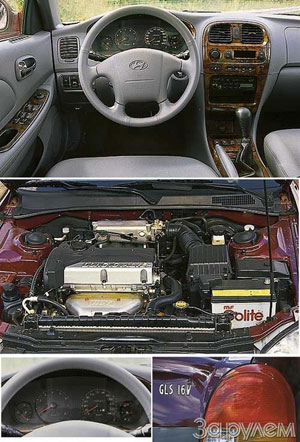
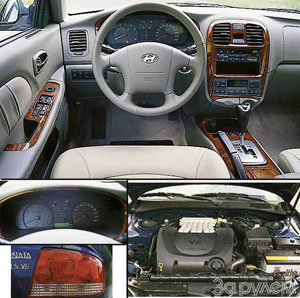
Text / Sergey Voskresensky
Photo / Alexander Polunin
Source: The magazine "Driving"
Hyundai Sonata 2001 - 2004
Hyundai Sonata 2001 test drives - 2004
Hyundai Sonata 2001 malfunctions - 2004
Hyundai Sonata malfunctions: Detailed information| Sonata 2001 - 2004 | |
|---|---|
| Engine |  |
| Transmission |  |
| Control system and suspension |  |
| Brake system |  |
| Air heating and air conditioning |  |
| Launch and charging system |  |
| Electric components and so on |  |
| Corrosion body stability |  |



